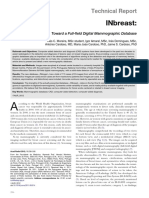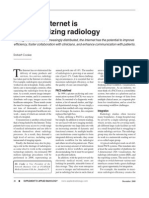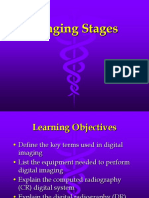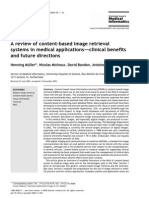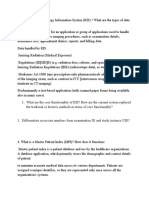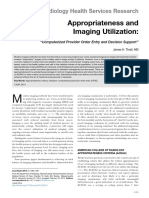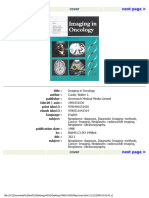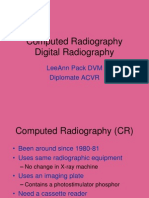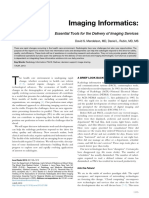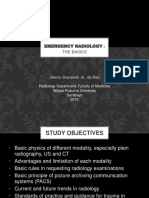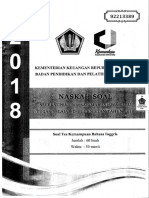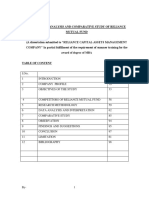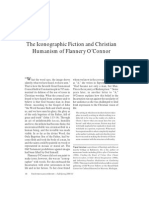A Web-Based ACR Index
Uploaded by
Silvana CiardulloA Web-Based ACR Index
Uploaded by
Silvana CiardulloDownloaded from www.ajronline.org by 200.49.142.150 on 09/04/19 from IP address 200.49.142.150. Copyright ARRS.
For personal use only; all rights reserved
Computers in Radiology
Chun-Shan Yam1
Jonathan Kruskal
A Web-Based ACR Index for
Arkadiusz Sitek Radiological Diagnoses
Michael Larson
OBJECTIVE. We created an online computer system that allows radiologists to access the
American College of Radiology (ACR) index for radiologic diagnoses from any Web browser.
CONCLUSION. A total of 11,260 indexes (10 anatomic, 722 pathologic, 90 subana-
tomic, and 10,438 subpathologic) were integrated into this online system. Users can navigate
the entire ACR hierarchic indexing structure with easy-to-use cascading dropdown lists. This
password-protected system also allows free-text searches, ACR index searches, and book-
mark functions. We have used this system in our departmental intranet for more than 2 years.
T
he first edition of the “Index for sion (for PC only). Today, most radiologists
Roentgen Diagnoses” was pub- still carry the ACR book, part of the book,
lished in 1955 by the American or copies of the book for coding teaching
College of Radiology (ACR), the second cases. Although the ACR coding system has
edition in 1961, and the third edition in been continuously improved since 1955,
1986. This index is also known as the “In- this invaluable teaching tool is still unavail-
dex for Radiological Diagnoses of the able on the internet [1].
American College of Radiology.” It is the Inspired by ACR policy to encourage ra-
standard guideline for academic radiolo- diologists and teaching faculties to use,
gists in classifying teaching cases according modify, or create new ACR indexes to suit
to the underlying anatomy and pathology their teaching needs [1], we developed a
[1]. All three editions have been printed as Web-based ACR index system to standard-
paperback books available exclusively ize terminology among our diverse faculty
through the ACR. Because nearly 10,000 and student bodies. This system was devel-
indexes are listed in each of these docu- oped on the basis of the original database
ments, the search process can be time-con- supplied in the ACR index CD-ROM (4th
suming and cumbersome. In 1992, a study edition). With this system, users can easily
was conducted at another institution to sim- navigate, search, and bookmark their com-
plify paper-based searches by replacing the monly used indexes.
hard-copy ACR book with a stand-alone
computer program [2]. In that study, each of
Received January 16, 2004; accepted after revision System Design
March 26, 2004. the 52 volunteers (21 radiologists, 21 resi-
1 dents, and 10 medical students) was asked The primary function of this system is to
All authors: Department of Radiology, Beth Israel
Deaconess Medical Center and Harvard Medical School, to code 30 teaching cases using the book allow users access to the ACR index from
WCC, Rm. 306, 1 Deaconess Rd., Boston, MA 02215. and a computer program (HyperCard, Ap- any Web browser. As shown in Figure 1,
Address correspondence to C.-S. Yam this online system uses a standard data-
(csyam@caregroup.harvard.edu).
ple Computer). Results indicated that using
the computer program to code cases yielded base-driven Web development approach.
AJR 2004;183:1517–1521
higher accuracy, confidence, and timeliness. This system contains three primary compo-
0361–803X/04/1835–1517 In 1999, the ACR released a fourth edition nents: a Web server, a data source, and
© American Roentgen Ray Society of the index as a single-user CD-ROM ver- scripting codes. The Web server provides
AJR:183, November 2004 1517
Yam et al.
Internet connectivity for client users to ac- Use of ASP and the Access database for radi- store the indexes for different anatomic re-
cess Web pages hosted at a specific Web ology teaching applications has been reported gions (Fig. 2B). Ten anatomic indexes are
address called a URL (uniform resource lo- previously [3, 4]. Writing ASP is similar to com- listed in the Anatomical table and 722 in
cator). The data source is the physical in- posing an HTML document because ASP and Sub-anatomical. The Pathological and Sub-
formation stored in a database for Web HTML are both plain-text documents and do not pathological tables store the indexes for
sharing. However, in standard Web pages require a compiler. Although ASP is not the only different pathologic findings and imaging
Downloaded from www.ajronline.org by 200.49.142.150 on 09/04/19 from IP address 200.49.142.150. Copyright ARRS. For personal use only; all rights reserved
written in HTML format, only static infor- programming tool that can be used for connect- techniques (Fig. 2C). Ninety indexes are
mation such as text and pictures can be ing databases to Web pages, it is widely used by listed in the Pathological table and 10,438
used. To connect a database for Web shar- Web programmers. Because of its popularity, in the Sub-pathological table. Currently,
ing, a data gateway, such as a scripting many resources are available online (e.g., ACR uses a 4-digit scheme for coding anat-
code, is often required. The basic functions www.aspfree.com, www.aspguru.com and omy and a 5-digit scheme for pathology or
of a scripting code can be summarized as a www.microsoft.com). However, using ASP and imaging techniques. Detailed information
four-step process: collect the user-re- a PC system to implement database-driven Web on the ACR Index for Radiological Diag-
quested information from a Web page, pass applications is not the only choice. Other sys- noses and its latest development is avail-
the information to a database engine, re- tems such as Mac OS, Linux and Unix, and other able to the public at the official ACR Web
ceive the results from the engine, and con- software (e.g., Coldfusion (www.Macrome- site (www.acr.org).
vert the results to a standard HTML Web dia.com), ChiliSoft (www.sun.com), and Linux-
page. In our implementation, we used the ASP (www.asp-linux.com) can also be used.
Microsoft Internet Information System (IIS Web Design
5.0, Microsoft Corporation) as the Web As previously stated, 11,260 indexes are
server software with a standard desktop PC Data Source encoded in the ACR database. To display all
(GX 150, Dell Inc.) running Windows 2000 We purchased a licensed CD-ROM ver- these indexes in static Web pages or as a
Professional (Microsoft Corporation). The sion of the ACR Diagnostic Index (4th edi- single PDF file would require hundreds of
cost of this PC system was $815 in October tion) from the ACR for departmental use. pages that the user must search through.
2002. We used Active Server Page (ASP The current price of this CD-ROM soft- Thus, when we designed the Web user inter-
2.0, Microsoft Corporation) for scripting ware is $85 for ACR members and $160 for face for this system, easy navigation of the
code and Open Database Connectivity nonmembers. It can also be purchased on- entire hierarchic ACR index was a priority.
(ODBC for Microsoft Access Database) for line at the official ACR web site For this critical requirement, we used sim-
the database engine. We chose a PC system (www.acr.org). The CD-ROM contains a ple cascading dropdown lists to display the
for Web development mainly because the database file (raddiag.mdb) with all the ACR indexes and simple mouse-click navi-
ACR database is already configured in the ACR indexes encoded. This database file is gation to each dynamically linked index
Microsoft Access 97 format, which is eas- stored in Microsoft Access 97 format. The page. Other functions such as free-text
ily integrated into Web applications using database contains four data tables: Ana- search, index search, and index bookmark-
ASP, ODBC, and IIS. All these software tomical, Sub-anatomical, Pathological, and ing were also built into the system to en-
components are already native to Windows Sub-pathological (Fig. 2A). The Anatomi- hance the user interface. Each of these
2000 and supported by Microsoft. cal and Sub-anatomical tables are used to functions is detailed in the following text.
Fig. 1.—System design for accessing American College of Radiology Index for Radiolog-
ical Diagnoses. IIS 5.0 = Microsoft Internet Information System (Microsoft Corporation).
1518 AJR:183, November 2004
Computers in Radiology
Index Navigation index (index [5]). In this example, nine en- Less than 50% narrowing of lumen). Again,
Figure 3A is a screen capture of the ACR tries are listed (e.g., [53] = Cardiac Valve, a single mouse click on any of these six en-
index system home page. This page has a [54] = Coronary Vessel). Again, each entry tries will take the user to the next level. In
simple dropdown list showing the 10 pri- in this page is linked to the next available this particular example, the next level will
mary anatomic regions. The number before subdigit index page. For example, if the be at the fourth digit.
each entry is the first-digit anatomic index user clicks on the Coronary Vessel entry
Downloaded from www.ajronline.org by 200.49.142.150 on 09/04/19 from IP address 200.49.142.150. Copyright ARRS. For personal use only; all rights reserved
(e.g., [0] = Breast). A mouse click on any of (index [54]), the system will jump to an- Free-Text Search
these 10 entries will take the user to the other index page showing all the subcoro- Further enhancing the user interface is the
next anatomic subdigit index page. For ex- nary vessels (Fig. 3C). Similarly, the free-text search function. Figure 4A is a
ample, if the user clicks on the sixth entry pathologic index can be navigated in the screen capture of the Anatomy search page
([5] Heart and Great Vessels), another index same manner. For example, Figure 3D is a showing the results of the search for the
page will appear as shown in Figure 3B. In screen capture of the third-digit index page word “artery.” In this example, eight indexes
this page, a dropdown list of all the second- under the category Heart/Cardiac Failure/ are found. Each index displayed on this page
digit indexes cascades from the first-digit Coronary Atherosclerosis (e.g., [761] = is linked to its subdigit index page (i.e., if the
Fig. 2.—Data tables of American College of Radiology (ACR) index.
A, Screen capture of ACR index database tables in Access 97.
B, Screen capture of Anatomical and Sub-anatomical tables in Access 97. Three
data fields used are aid, sid, and description. Field aid stands for anatomic id and
stores primary body indexes (e.g., [0] = Breast). Field sid stands for subanatomic id
and stores secondary body indexes (e.g., [1] = Upper outer quadrant).
C, Screen capture of Pathological and Sub-pathological tables in Access 97. In
these two tables, new data field pid is for pathological id representing either pri-
mary pathology findings (e.g., [2] = Inflammation) or primary imaging techniques
(e.g., [1] = Normal, Technique). Field sid stands for subpathology id representing ei-
ther subpathologic findings (e.g., [0312] = Breast/ Neoplasm/ Benign/ Papilloma) or
subsidiary imaging techniques (e.g., [14] = Spot compression).
A
B C
AJR:183, November 2004 1519
Yam et al.
user clicks on the first entry, [541] = Right cading dropdown lists for both anatomy and clicks on the third entry [541.763], the re-
coronary artery, the system will jump to an pathology indexes with links to subdigit in- sults for both anatomy and pathology in-
index page with the equivalent digit level dex pages. The ACR index can be stored for dexes for this particular ACR index will be
(Fig. 3C). The same mechanism is used for quick reference by clicking the Bookmark displayed (Fig. 4C).
pathology searches (Fig. 4B). this Index hyperlink located at the left bot-
tom of this page (Fig. 4C).
Downloaded from www.ajronline.org by 200.49.142.150 on 09/04/19 from IP address 200.49.142.150. Copyright ARRS. For personal use only; all rights reserved
ACR Index Search Performance
Similar to the free-text search, the ACR Index Bookmark We have been using this Web-based ACR
index search was designed for searching Figure 4D is a screen capture of a sample index for intranet access since March 2002.
specific ACR indexes. Figure 4C is a screen bookmark page with 12 indexes stored. Today we are still using the original software
capture of the search results of an index Each bookmark entry is linked to its de- and hardware configurations for this system
[541.763]. The results are displayed as cas- tailed index page. For example, if the user with no major modifications. The system has
A B
C D
Fig. 3.—Sample pages of American College of Radiology index.
A, Screen capture shows main anatomic page with first-digit indexes.
B and C, Screen capture of subanatomic pages show second-digit indexes (B) and third-digit indexes (C). As shown in C, all third-digit coronary vessels are displayed (e.g.,
[541] = Right Coronary Artery, [542] = Left Coronary Artery, etc.). In this example, cascading list ends at third-digit index page because no other subindexes exist for sub-
coronary vessels. However, for other body parts anatomy index can be extended to four digits (e.g., [4331] = Skeletal System/Wrist and Hand/Carpal Bone/Scaphoid).
D, Screen capture of subpathologic page shows third-digit indexes.
1520 AJR:183, November 2004
Computers in Radiology
Downloaded from www.ajronline.org by 200.49.142.150 on 09/04/19 from IP address 200.49.142.150. Copyright ARRS. For personal use only; all rights reserved
A B
C D
Fig. 4.—Search and bookmark pages of American College of Radiology Index for Radiological Diagnoses.
A and B, Screen captures show free-text search pages for anatomy indexes (A) and pathology indexes (B).
C and D, Screen captures show search page (C) and bookmark page (D).
been operating continuously 24 hr a day thenticated users can browse the entire hierar- intranet for more than 2 years. All the ASP
without interruption except for necessary chic ACR index system using cascading pages described in this article are available as
maintenance. Users are required to log on to dropdown lists and navigate between index open source for academic institutions.
the system using their hospital personal iden- pages using simple mouse clicks. On the ba-
tification keys. sis of feedback from faculty members, resi-
References
dents, and medical students, this system was
1. The official Web Site of the American College of
modified to also provide free-text searches, Radiology (ACR) (http://www.acr.org). Accessed
Discussion ACR index searches, and bookmark func- January 12, 2004
We described a Web-based computer sys- tions to enhance the user interface. With this 2. Renfrew DL, Bass SH, Albanese MA, Whitis BM.
tem for radiologists to easily navigate the online access capability, the ACR index has Hypercard coding system for the ACR index for ra-
ACR index for radiologic diagnoses. We used been easily used for standardized coding of diological diagnoses. AJR 1992;158:669–672
the official index database supplied in the teaching cases across all sections and subspe- 3. Sistrom C, Drane W. Networked ICD-9 coding system
for a radiology department. AJR 2003;176:335–339
ACR index CD-ROM (4th edition). A total of cialties in radiology. Without such standard-
4. Tran TH, Roach NA, O’Kane PL, Thune M. Cre-
11,260 indexes (10 anatomic, 722 pathologic, ization, valuable teaching cases would be lost ating a digital radiographic teaching file and data-
90 subanatomic, and 10,438 subpathologic) or misplaced. This Web-based ACR index has base using a PC and common software. AJR
were integrated into this online system. Au- been used successfully in our departmental 2000;175:325–327
AJR:183, November 2004 1521
You might also like
- Basic Radiology 1st Edition Michael Y. M. Chen PDF Download100% (10)Basic Radiology 1st Edition Michael Y. M. Chen PDF Download81 pages
- A Cost Effective Web Based Teaching File System 2004 Journal of Digital ImagingNo ratings yetA Cost Effective Web Based Teaching File System 2004 Journal of Digital Imaging5 pages
- Applied Radiology Featured Article (Via Radrounds)No ratings yetApplied Radiology Featured Article (Via Radrounds)3 pages
- Get Through Radiology For The MRCS and The FRCS - 1st Edition Full Book Download100% (14)Get Through Radiology For The MRCS and The FRCS - 1st Edition Full Book Download14 pages
- Medical Image Management in Healthcare Enterprise: Technology & ApplicationsNo ratings yetMedical Image Management in Healthcare Enterprise: Technology & Applications4 pages
- RADIOLOGY - Clinical Radiology - The Essentials 4E (2014) (PDF) (UnitedVRG)90% (31)RADIOLOGY - Clinical Radiology - The Essentials 4E (2014) (PDF) (UnitedVRG)562 pages
- Immediate Download Basic Radiology 1st Edition Michael Y. M. Chen Ebooks 2024100% (7)Immediate Download Basic Radiology 1st Edition Michael Y. M. Chen Ebooks 202484 pages
- Introduction To Picture Archive and CommunicationNo ratings yetIntroduction To Picture Archive and Communication7 pages
- Computed Radiography Digital Radiography: Leeann Pack DVM Diplomate AcvrNo ratings yetComputed Radiography Digital Radiography: Leeann Pack DVM Diplomate Acvr23 pages
- Section 3 - Introduction To Medical Imaging - Ipynb - ColabNo ratings yetSection 3 - Introduction To Medical Imaging - Ipynb - Colab10 pages
- International Journal of Computational Engineering Research (IJCER)No ratings yetInternational Journal of Computational Engineering Research (IJCER)11 pages
- A Content-Based Approach To Medical Image Database RetrievalNo ratings yetA Content-Based Approach To Medical Image Database Retrieval34 pages
- Imaging Informatics:: Essential Tools For The Delivery of Imaging ServicesNo ratings yetImaging Informatics:: Essential Tools For The Delivery of Imaging Services18 pages
- Medical Image Storage System For Content-Based Retrieval: AbstractNo ratings yetMedical Image Storage System For Content-Based Retrieval: Abstract8 pages
- Computed Radiography: Dawn Guzman Charman, M.Ed., R.T. Rad Tech ANo ratings yetComputed Radiography: Dawn Guzman Charman, M.Ed., R.T. Rad Tech A95 pages
- Practical Radiology: A Symptom-Based Approach. First Edition. ISBN 0803628323, 978-0803628328100% (25)Practical Radiology: A Symptom-Based Approach. First Edition. ISBN 0803628323, 978-080362832823 pages
- Bi Rads, C Rads, Cad Rads, Li Rads, Lung Rads, Ni RadsNo ratings yetBi Rads, C Rads, Cad Rads, Li Rads, Lung Rads, Ni Rads5 pages
- ACR Appropriateness Criteria Brea 2017 Journal of The American College of RNo ratings yetACR Appropriateness Criteria Brea 2017 Journal of The American College of R9 pages
- (PDF Ebook) Clark's Essential PACS, RIS and Imaging Informatics - 1st Edition Optimized DOCX DownloadNo ratings yet(PDF Ebook) Clark's Essential PACS, RIS and Imaging Informatics - 1st Edition Optimized DOCX Download15 pages
- Omental Tuberculosis: A Rare Presentation of Abdominal TB: December 2019No ratings yetOmental Tuberculosis: A Rare Presentation of Abdominal TB: December 20194 pages
- Tenpin:kw: Kementerian Keuangan Republik Indonesia Badan Pendidikan Dan Pelatihan Keuangan100% (1)Tenpin:kw: Kementerian Keuangan Republik Indonesia Badan Pendidikan Dan Pelatihan Keuangan10 pages
- Assignment-1-3 Merged PADI DANYI 210104065No ratings yetAssignment-1-3 Merged PADI DANYI 21010406595 pages
- Practical Research 2 Theoretical and Conceptual Framework Jerry V. Manlapaz, RN, PHD, Edd, LPT Theoretical and Conceptual FrameworkNo ratings yetPractical Research 2 Theoretical and Conceptual Framework Jerry V. Manlapaz, RN, PHD, Edd, LPT Theoretical and Conceptual Framework5 pages
- Namukasa V Namayanja 4 Others 2024 UGCA 292 (11 October 2024)No ratings yetNamukasa V Namayanja 4 Others 2024 UGCA 292 (11 October 2024)9 pages
- Zscaler Cisco SD WAN Deployment Guide FINALNo ratings yetZscaler Cisco SD WAN Deployment Guide FINAL129 pages
- Perfect Competition and The Creativity of The Market (2001) Louis Makowski and Joseph M. OstroyNo ratings yetPerfect Competition and The Creativity of The Market (2001) Louis Makowski and Joseph M. Ostroy58 pages
- Introduction To Pipe Stress Analysis-Sam Kannappan-1986No ratings yetIntroduction To Pipe Stress Analysis-Sam Kannappan-1986129 pages
- Documentation For Emergency Ambulance Booking Web App - Data ModelsNo ratings yetDocumentation For Emergency Ambulance Booking Web App - Data Models2 pages
- English Worksheets Class 1 Nouns Plurals Verbs Adjectives and PunctuationNo ratings yetEnglish Worksheets Class 1 Nouns Plurals Verbs Adjectives and Punctuation6 pages








